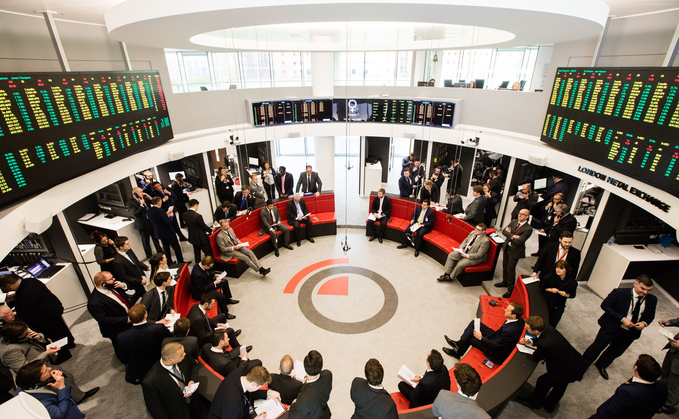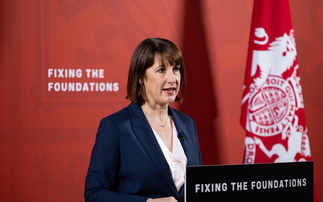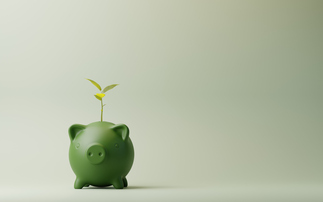
The LME is the world's oldest and largest industrial metals exchange - BusinessGreen investigates how it is preparing for the battery metal goldrush and responding to calls for a more sustainable metals industry
What role do metals exchanges have in driving a sustainable transition to a low-carbon economy? As the nexus where miners and metals producers meet the financiers that bulk buy commodities for automakers, industrial manufacturers, and aviation firms, many would argue they should be enabling conversations around sustainable best practices and establishing 'green' materials standards that could drive the decarbonisation of manufacturing, construction, transportation and technology.
The metals and mining sector is responsible for supplying the building blocks of the clean technologies and buildings of the future, but it is also one of the most emissions intensive industries in the world, generating up to seven per cent of global greenhouse gas emissions. As such metals markets are in a unique position to try and square this circle, by creating a trading framework which ushers in a more sustainable metals industry.
As the world's largest metal exchange and the global reference point for pricing industrial metals, the London Metals Exchange has a particularly priveleged purview in this regard. Last year, the 150-year-old market facilitated $15.6tr worth of trades - nearly five times the UK's total gross domestic product. Specialising in metal futures and options, the LME also operates a global warehouse network of more than 600 storage facilities, and boasts the distinction of being the last physical trading floor in Europe.
In times gone by the LME might push back at any assertion that the exchange has any role to play in stewarding the direction of the aluminium, copper, zinc, tin, scrap, and other markets it enables. Much in the line with the traditional light-touch regulatory ethos of the City of London, it has historically preferred a hands-off approach to regulation or pre-emptive market intervention, avoiding caps or constraints on the grounds that supply and demand is the best arbiter of metals prices.
But climate-threatened times may call for new approaches, even for an 150 year old institution like the LME. Last year, the market introduced mandatory responsible sourcing commitments that metals must meet to be listed on its prestigious "brands list" of metals, meaning for the first time, products with the LME's stamp traded on the exchange were required to not only meet requirements around purity or shape but also around human rights and corruption. Meanwhile, the LME's digital climate disclosure platform is now more than a year old, with producers of listed brands invited to log their climate credentials, alongside artisanal miners looking to prove their sustainability credentials. And just last month, Matthew Chamberlain, the LME's chief executive, said the organisation wanted to work with stakeholders to "build a better, more sustainable market" as he unveiled the LME's intention to achieve net zero emissions by 2040.
At the same time, recent geopolitical turmoil has tested the LME's reticence to intervene in markets. In March, the bourse took the unprecedented step of halting nickel trading and cancelling trades in the wake of wild price swings following Russia's invasion of Ukraine. The move - which was informed by Russia's position as one of the world's leading nickel producers - has incurred the wrath of hedge fund managers who lost out on deals, with a number currently suing for hundreds of millions in damages. The exchange has since introduced daily price move limits to prevent future price spikes and more transparency requirements from buyers over trades happening outside the exchange - known as "over-the-counter" trades. Clearly, it is an organisation is the midst of an evolution.
Speaking to BusinessGreen, the LME's first ever sustainability chief, Georgina Hallett, insists the organisation's recent green initiatives have been led by the market, and not vice versa. "We're trying to support the metals industry in establishing itself as the cornerstone of sustainability," she says. "Because obviously, there's a huge role for metals in sustainable transition, for instance the metals in EVs and wind farms. But people increasingly understand that it's no good being useful for green technology, if they're not themselves as sustainable as possible."
Hallett, who was appointed chief sustainability officer after managing the launch of the LME's new responsible sourcing requirements in her other role as chief of staff, says engaging with metals buyers, sellers, and traders on sustainability is a challenge. "The LME tried to follow the lead of the market, we try and meet what they are trying to do rather than being an ethical standard setter - and that's complicated," she explains. "It takes a lot of engagement, trying to get that scope right."
Sustainability passports
At the heart of the LME's sustainbility programme is its LMEpassport platform, a website launched last year which invites producers of listed brands to publicly disclosure the climate credentials of their products on a voluntary basis. So far 210 of the LME's 443 listed metals from 30 different companies have been uploaded to the site, which - where possible - draws on emissions methodologies developed or recognised by leading industry groups such as the Nickel Institute, the International Zinc Association, and the International Aluminium Institute. "The utopian vision is to be a one-stop-shop where you can go and see all the information you need about that brand, that piece of metal, and that producer in one place," says Hallett.
The platform, initially borne out of the need to digitise metals records, has received plaudits from metals buyers looking to decarbonise their supply chains, she adds. "We are increasingly hearing from the consumer group, the OEMs [original equipment manufacturers], and so on that its really useful to them," she says. "They are beginning to talk to their suppliers, who supply them with metal and say please can you get this information up?"
But Hallett acknowledges that climate auditing remains a challenge for smaller producers with less resource and manpower - an issue that is further exacerbated by a global shortage in metals sustainability auditing services. "The Big Four [auditing firms] are only just getting into this area of responsible sourcing and sustainability audit," she notes. "It's a totally different thing, doing a financial audit to going to boots on the ground at a mine site, checking for responsible sourcing issues."
The other big piece of the LME's sustainability agenda is its responsible sourcing requirements, which came in last year and focus on human rights and conflict finance and are mandatory for LME-listed metals brands. There is early evidence the new rules are working. In October, 19 companies were delisted for failing to comply with the requirements.
But the bourse has to date resisted calls to update its responsible sourcing rules to include more robust requirements around environmental and climate risks. Firms are required to maintain an ISO14001 environmental management system, but there is no particular standard they need to meet. Global Witness has described the lack of mandatory environmental measures on an industry with a notorious environmental record a "glaring omission".
Hallett says that at the time of the industry consultation on the standards, there was neither the interest nor the methodologies required to mandate climate reporting requirements for producers. While the ongoing work around standardising voluntary emissions disclosures on LMEPassport could ultimately inform a future update to the responsible sourcing requirements, the LME is sticking to its current approach for now, she says.
"We are quite reluctant to keep moving the goalposts on the people who produce those brands, because it's a huge amount of work and it takes a massive amount of time and resource," she says. "It is still super new, it takes a long time to embed it. Everything else we have done has been on a voluntary basis, premised on us being at the central point in the marketplace between production - the mining side - and the consumption side, the people who fabricate cars and aeroplanes."
Low-carbon premiums and green asset classes
True to its free market philosophy, the LME does not take a view on whether 'greener' versions of metals should become their own asset class or command a premium on conventionally-produced metals. But, Hallett says, it does have a responsibility to assess whether there is an appetite for such a distinction from its users.
As such, the LME has partnered with online metals marketplace Metalshub to develop a spot trading platform for base metals which works as a digital marketplace where buyers and sellers can barter, or put out tenders, for metals with specific sustainability characteristics. The plan is to monitor the activity happening on the site to gauge whether there is a case for a premium for green metals to be attached to the LME's standard contracts.
"What we can do as a market infrastructure provider is facilitate the ability to discover whether a premium should exist," Hallett explains. "It wouldn't be for us to say it should exist, and here is what it costs. But we can provide the forum by which that gets discovered organically."
For the moment, it is too soon to make any conclusions from the data, she notes. "Anecdotally, we hear that some premiums are being paid, but it is very difficult to get any substantial evidence around that," she says. "It is still a very nascent market."
In 2020, the LME announced it was exploring the prospect of making low-carbon aluminium its own asset class, after significant pressure from Russian metal producer Rusal, which powers its smelters with hydropower instead of fossil fuels. The company argued that establishing a separate asset class for low-carbon aluminium is necessary to help meet climate targets and create a green benchmark other aluminium producers can strive to meet.
But other aluminium sellers argued a low carbon contract for the metal would hurt the overall market because it would eat away at the liquidity on primary aluminium futures contracts. As the world's largest aluminium producer outside of China, they argued that a shift in Rusal's supplies away from the main exchange could cause major disruption. The potential for market turbulence was underlined - albeit in very different circumstances - this year, after the Kremlin's invasion of Ukraine sent aluminium prices to an all-time high, as the market priced in the potential loss of Russian metal from the market.
For the time being, the LME has yielded to the concerns of some market participants and decided not to draw a line between the low and high carbon aluminium sold on its exchange. "The LME has said publicly that it was looking at [making low carbon aluminium it is own asset class] as an option, it is probably not pursuing that at the moment," Hallett confirms. "What would make more sense and be more feasible is for the primary aluminium contract to stay as it is, and then to launch a premium contract."
It is a decision the LME is presumably unlikely to revisit any time soon, given Russia's invasion of Ukraine. A consultation on Russian aluminium, nickel, and copper being traded on the LME and stored in its global fleet of warehouses is ongoing and expected to cause significant upset, whichever conclusion it reaches. Coming after the controversial decision to freeze and cancel nickel trades, the situation has been dubbed by some commentators as the LME's biggest crisis in decade.
With the exception of aluminium, supply of so-called low-carbon metals remains too small at present to meet the liquidity requirements that would allow them being given their own, dedicated futures contracts on the exchange, according to Hallett. "For an exchange traded contract to work, you need quite a lot of underlying metal to provide the liquidity," she explains.
Metals contracts for modern times
The LME has, however, launched a number of other contracts designed to meet demand for metals that support the EV transition and circular economy. In June 2021, a new future contract for battery-grade lithium was launched, in a bid to provide EV manufacturers with a more consistent price signal in a historically volatile market. The move was announced alongside a new contract for aluminium scrap focused on the US used beverage can market and two steel scrap contracts focused on Taiwan and India. The scrap contracts were spurred by "the push behind recycling" and to give purchasers the same potential to hedge their price risk as those that are buying primary materials, according to Hallett.
But she notes that significantly more work needs to be done to create credible emissions methodologies for scrap metals, given how recycled metals can range from offcuts of a primary metalmaking process to metal that has been through a whole consumer cycle. "How you measure emissions depends on how you've defined scrap or recycled in the first place," she notes, adding that defining scrap is a "contentious" issue.
Moreover, more consensus needs to be reached about what "responsibly recycled" means to ensure the scrap industry does not result in negative health and social impacts. Recycled metals are widely regarded as more sustainable, Hallett acknowledges, but this is not always the case. In the lead battery recycling sector, for instance, illegal operations frequently spill acid and lead dust on the ground and smelt lead in open-air furnaces resulting in toxic fumes.
"Questions remain along the value chain of recycling," Hallett reflects. "Has it been sourced in a way that minimises the risk to humans and respecting human rights and social risks? We are getting more sophisticated about asking those questions, and we can't really say [a metal] has been recycled responsibly until we've answered them."
Clearly, the LME is aware it must adapt as it works to maintain its legacy into the 21st century. Hallett reflects that the organisation has been on a "steep learning curve" in recent years and will need to keep evolving to retain its globally significant role in a world transitioning to a low carbon economy.
"Metals is an area that is constantly evolving, as a real-world commodity," she says. "If the LME can't adapt to that and meet the changing requirements the world expects you to make overnight, then we will fail. We have really taken that lesson on board and the LME is really getting up to speed with modern times."
This article is part of the Net Zero Commodities Hub, sponsored by Wood Mackenzie.









